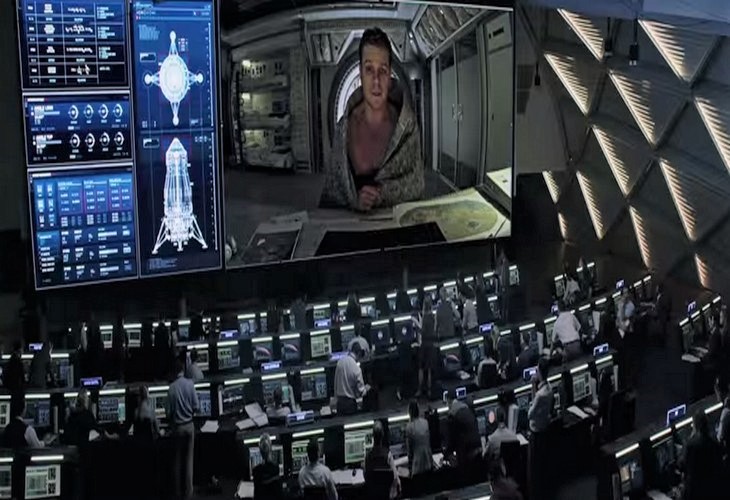The Martian (2015)
“Improvise! Adapt! Overcome!” On the surface, that sound advice from the U.S. Marines – and second-handedly from Clint Eastwood and Bear Grylls – seems the whole theme of this Ridley Scott film about an American astronaut several decades in the future who has to figure out how to survive after he ends up inadvertently stranded on Planet Mars. But there’s even more to the movie than that.
The story begins with the crew of NASA’s Ares 3 mission doing science at their Martian base camp. “Ares” is a classical reference: Mars was Rome’s god of war and Ares was his Greek equivalent. A sudden sandstorm so fierce that it threatens to tip over their MAV (Mars Ascent Vehicle) makes them decide to end their mission, but the storm slams crewman Mark Watney (Matt Damon) out into impenetrable darkness. Under Commander Melissa Lewis (Jessica Chastain), the team, receiving no telemetry readings from his suit, concludes he is dead. With extreme reluctance they blast off for Earth.
The next day, or Sol (a Martian day), Watney wakes up injured, makes his way back to the camp’s HAB (Habitat), and performs surgery on himself to remove an antenna that impaled him in the abdomen during the storm. This is the first of many times Watney shows his resilience in the face of setbacks. He evidences level-headedness as he assesses his situation and starts making plans. He also displays some softly wry humor as he starts making daily video recordings of his progress.
https://youtu.be/VYcQHcBvS6E
At one point Watney stops in his tracks and makes a decision: “I’m not gonna die.”
Watney is not bitter; he knows the crew had to flee and was sure he was dead. The next Mars mission, Ares 4, though, is four years in the future and his food supply will run out before then. A botanist, as it happens, he makes an indoor garden, plants potatoes from the crew’s stash and fertilizes them with human waste. Yuck – but it works, and soon he has 400 plants flourishing. He also creates a water system inside the HAB.

Watney is not upset about his immense predicament. In fact, he holds a small crucifix that belongs to his buddy, crew pilot Major Rick Martinez (Michael Peña), and admits he needs help. Thanks to damage from the storm he can’t communicate with Earth, so he must tackle that huge obstacle.
Watney doesn’t know it yet, but help eventually will be on the way. That’s because back on Earth, Mindy Park (Mackenzie Davis) of Mission Control knows he is alive. Via orbiter images she has spotted evidence of his outdoors activity at the base camp. She quickly notifies NASA director Teddy Sanders (Jeff Daniels) – but as luck would have it, right after he has presided at a funeral for Watney.
Meanwhile, the Ares 3 crew is en route to Earth in their ship, the Hermes. Sanders decides not to tell them Watney is alive just yet; he believes that could distract them from their return voyage duties. On Mars, Watney takes initiative and drives his rover to an old Pathfinder mission site, where he unearths the vehicle and finds it still works. One thing leads to another, and soon he and NASA can communicate.

NASA tells Watney they haven’t told the crew he’s alive. The agency finally tells the crew he is living. But a disaster now happens on Mars: an explosion in the HAB destroys the potato crop. Watney weathers the bad news, and a bantering message from his friend Martinez makes him smile. Back home, Jet Propulsion Lab young scientist Rich Purnell (Donald Glover) gets an idea about how to save the day. But another disaster occurs: a NASA re-supply rocket blows up after launch.
Now the Communist Chinese space agency decides to give NASA a top-secret booster rocket to help save Watney, and Sanders accepts the offer. This is, um, improbable, to put it mildly. Not only that, but the film completely ignores what would really happen: America’s private enterprise rocket firms would be the ones to offer help. To moviemakers, businesses are to bash, not portray positively.
The JPL’s youthful and unpretentious Purnell pitches his idea to Sanders and his NASA team: have Hermes circle the globe and use Earth’s gravity to boost its speed, slingshot-style, and send it back toward Mars, saving precious time. “I done the math,” he tells them. After Sanders nixes the plan as being too risky for the crew, Ares 3 mission director Mitch Henderson (Sean Bean) leaks it to the Ares crew and they decide unanimously to disobey Sanders’ orders and adopt it to go rescue Watney.
Sanders has no option but to agree now, but he complains to Henderson, “This is bigger than one man.” In three words that exemplify the film’s ethos, Henderson replies firmly, “No, it’s not.”
Watney now drives his rover 2,000 miles across Mars’ beautiful desolation to a pre-selected landing site where he will board an ascent vehicle that has been awaiting Ares 4. NASA and the Ares 3 crew have been doing their own “improvising and adapting,” and now – SPOILER ALERT – they and Watney do the “overcoming” by executing a cliff-hanger rescue in space. Crowds around the world, who have been watching a live broadcast, rejoice. Watney and the crew have a joyous reunion.
https://youtu.be/4uLViM50EeM
In the denouement, Watney, back on Earth and now an instructor of astronaut candidates, tells his class that when things go south in space, as they will, they can either accept it or they can start to solve their problems one by one, and that is the only way they’ll get to go home. After all, he knows.
The movie is based on Andy Weir’s 2011 novel of the same name. The MPAA rating is PG-13 “for some strong language, injury images, and brief nudity.” (The “strong language” is cursing and obscenities. The nudity is a rear view of Watney as he exits his ablutions.) Ridley Scott directed and was a producer. Drew Goddard wrote the script. Dariusz Wolski was the cinematographer, Arthur Max the production designer, Janty Yates the costume designer, Pietro Scalia the editor and Harry Gregson-Williams the composer.
— Dan Engler













